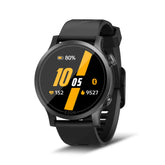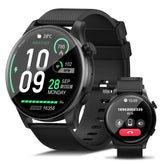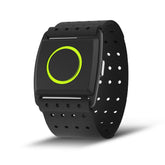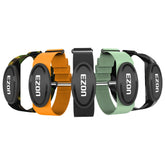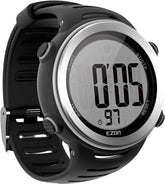10K Training Tips: Step - by - Step Guide with Wearable Insights
Preparing for a 10K race requires more than just logging miles—it’s about strategic training, precise pacing, and leveraging data to fine-tune every effort. This guide combines expert 10K training tips with insights from step count watch and digital sports watch to help you build speed, stamina, and confidence, all while shaving minutes off your 10K time improvement journey.
1. Training Principles for 10K Success
A. The 80/20 Rule: Balance Intensity and Recovery
- 80% Easy Runs: Keep 5–6 days/week at Zone 2 (60–70% max heart rate) to build an aerobic base—use a digital sports watch to ensure you’re not accidentally running too fast.
- 20% Intensity Work: 1–2 days/week of tempo runs or intervals to boost your lactate threshold (e.g., 5K race pace training).
B. Step Count Watch: The Silent Pacing Coach
- Cadence: Aim for 170–180 steps/minute to reduce injury risk—your watch’s real-time cadence data helps you maintain optimal turnover.
- Cumulative Steps: Gradually increase weekly steps by 10% (e.g., 30,000 steps → 33,000 steps) to avoid overtraining.
2. 12-Week Training Plan: From Beginner to Race Ready
Phase 1: Base Building (Weeks 1–4)
- Goal: Build consistency and improve running economy.
-
Key Workouts:
- Easy Runs: 30–40 minutes at Zone 2, focusing on smooth form (midfoot strike, relaxed shoulders).
- Stride Drills: 10-minute post-run drills (high knees, butt kicks) to improve neuromuscular coordination.
- Wearable Insight: Use a step count watch to track daily activity—aim for 8,000–10,000 steps on non-running days.
Phase 2: Intensity & Tempo (Weeks 5–8)
- Goal: Introduce race-specific intensity and build speed endurance.
-
Key Workouts:
- Tempo Runs: 20–30 minutes at 75% max heart rate (~30 seconds slower per km than 5K race pace), using your watch’s pace alerts to stay on target.
- Fartlek Training: 45-minute run with 1-minute fast bursts (Zone 4) + 2-minute easy recovery—let your watch auto-detect effort changes.
- Pacing Strategy: Use GPS to map routes with varying terrain (50% flat, 50% rolling hills) to build all-around strength.
Phase 3: Peak & Simulation (Weeks 9–12)
- Goal: Maximize race-specific fitness and practice pacing.
-
Key Workouts:
- 10K Simulation Run: 10K at goal pace, followed by 10-minute cool-down—analyze your watch’s data to see if you can maintain pace evenly.
- Interval Training: 6x1K at goal pace with 90-second jog recovery, focusing on quick turnover and controlled breathing.
- Recovery Focus: Use your watch’s HRV (heart rate variability) to schedule rest days—low HRV means add an extra easy run.
3. How Digital Sports Watches Fine-Tune Your Training
A. Real-Time Data for Perfect Pacing
- Pace Alerts: Set your goal 10K pace (e.g., 5:00/km) and let the watch vibrate if you’re too fast/slow—critical for negative splits (second half 5–10 seconds faster per km than the first).
- Heart Rate Zone Tracking: Ensure tempo runs stay in Zone 3 (70–80% max heart rate) to avoid burning out early.
B. Recovery Management
- Training Load Analysis: Watch algorithms calculate weekly stress scores—aim for a 10–15% increase in load week-over-week.
- Sleep Monitoring: Ensure 7–9 hours/night, with 15–20% deep sleep for muscle repair—use watch insights to adjust bedtime routines.
C. Race-Day Prep
- Course Preview: Download race course GPX files to your watch for real-time elevation alerts (e.g., “Steep climb ahead—save energy”).
- Nutrition Reminders: Program gel intake alerts (every 4K) to avoid bonking during the race.
4. Technique Tips to Improve 10K Time
A. Form Adjustments
- Arm Swing: Elbows at 90°, hands relaxed—use your watch’s accelerometer data to detect excessive upper body movement.
- Foot Strike: Midfoot strike on pavement, forefoot on trails—analyze stride symmetry in post-run data (aim for <5% imbalance).
B. Breathing Control
- Rhythmic Breathing: Pair breaths with steps (e.g., inhale 2 steps, exhale 2 steps) to maintain oxygen efficiency—practice during easy runs to make it second nature.
5. Race-Day Strategy: Execute with Precision
A. Warm-Up
- Dynamic Stretching: 10 minutes of leg swings, hip circles, and light strides to raise heart rate to Zone 1.
- Pace Test: 2-minute race pace burst to ensure your watch’s GPS is calibrated and your body feels the target speed.
B. Mid-Race Pacing
- First 5K: Run 5–10 seconds slower per km than goal pace to avoid burnout—let your watch’s lap data keep you accountable.
- Final 2K: If heart rate is steady, gradually increase pace—use the watch’s remaining distance feature to gauge effort.
C. Finish Strong
- Sprint Strategy: With 400 meters to go, surge to Zone 5 effort, using your watch’s real-time pace to ensure you don’t peak too early.
6. Common Mistakes to Avoid
- Overtraining on Easy Days: Use your watch’s heart rate data to ensure easy runs stay relaxed (conversational pace—you should be able to speak in full sentences).
- Ignoring Recovery: A 5 BPM increase in resting heart rate means take a rest day—don’t skip it for a planned workout.
- New Gear on Race Day: Test shoes, gels, and watch settings in training to avoid surprises (e.g., watch GPS signal loss in tunnels).
7. Gear Recommendations for 10K Success
A. Step Count Watch Features to Prioritize
- GPS Accuracy: Multi-band GPS (GPS + GLONASS) for precise route tracking, especially in urban areas (e.g., EZON GPS Series).
- Battery Life: 20+ hours in GPS mode for long training runs and race day.
B. Digital Sports Watch Must-Haves
- Heart Rate Monitoring: Optical or chest-strap options for accurate intensity control (recommend EZON Heart Rate Series for wrist-based precision).
- Smart Alerts: Customizable alerts for pace, heart rate, and nutrition—keep your focus on running, not checking your watch.
8. Sample Weekly Training Schedule (Weeks 5–8)
| Day | Activity | Wearable Use |
|---|---|---|
| Monday | Easy Run (40 mins, Zone 2) | Monitor heart rate zone, ensure <70% max HR |
| Tuesday | Tempo Run: 2x15 mins (Zone 3) | Pace alerts to maintain target pace (e.g., 5:00/km) |
| Wednesday | Cross-Training (Cycling/Swimming) + Core | Log non-running activity, track daily steps |
| Thursday | Easy Run (30 mins) + Cadence Drills (180 steps/min) | Real-time cadence data to adjust stride length |
| Friday | Rest or Yoga | Monitor HRV to ensure adequate recovery |
| Saturday | Long Run (60 mins, Zone 2) | Route planning to avoid repetitive paths |
| Sunday | Form Drills (Strides, High Knees) | Analyze movement data alongside watch metrics |
9. FAQs: Your 10K Training Questions Answered
Q: How do I set my 10K goal pace?
- Base it on your current 5K time: 10K goal pace = 5K pace + 15–30 seconds per km (e.g., 25-minute 5K → 5:15–5:30/km for 10K).
Q: How to avoid knee pain during training?
- Maintain a cadence ≥170 steps/min using your watch’s real-time data; add 1–2 days/week of strength training (squats, glute bridges) to stabilize knees.
Q: Should I taper before the race?
- Yes, reduce mileage by 30–40% (e.g., 50K last week → 30–35K this week). Use your watch’s training load data to taper safely while maintaining intensity.
Train Smarter, Run Faster
With 10K training tips guided by step count watch and digital sports watch, you’ll transform raw effort into strategic progress. Let data fine-tune your pace, protect against overtraining, and build the confidence to crush your 10K time improvement goals.
Remember, every step counts—literally. Gear up with a reliable wearable, follow the plan, and trust the process. Race day will arrive, and you’ll toe the line ready to run stronger, faster, and smarter than ever before.
EZON Watch: Professional sports technology brand
https://ezonwatch.com
https://ezonwatch.com
